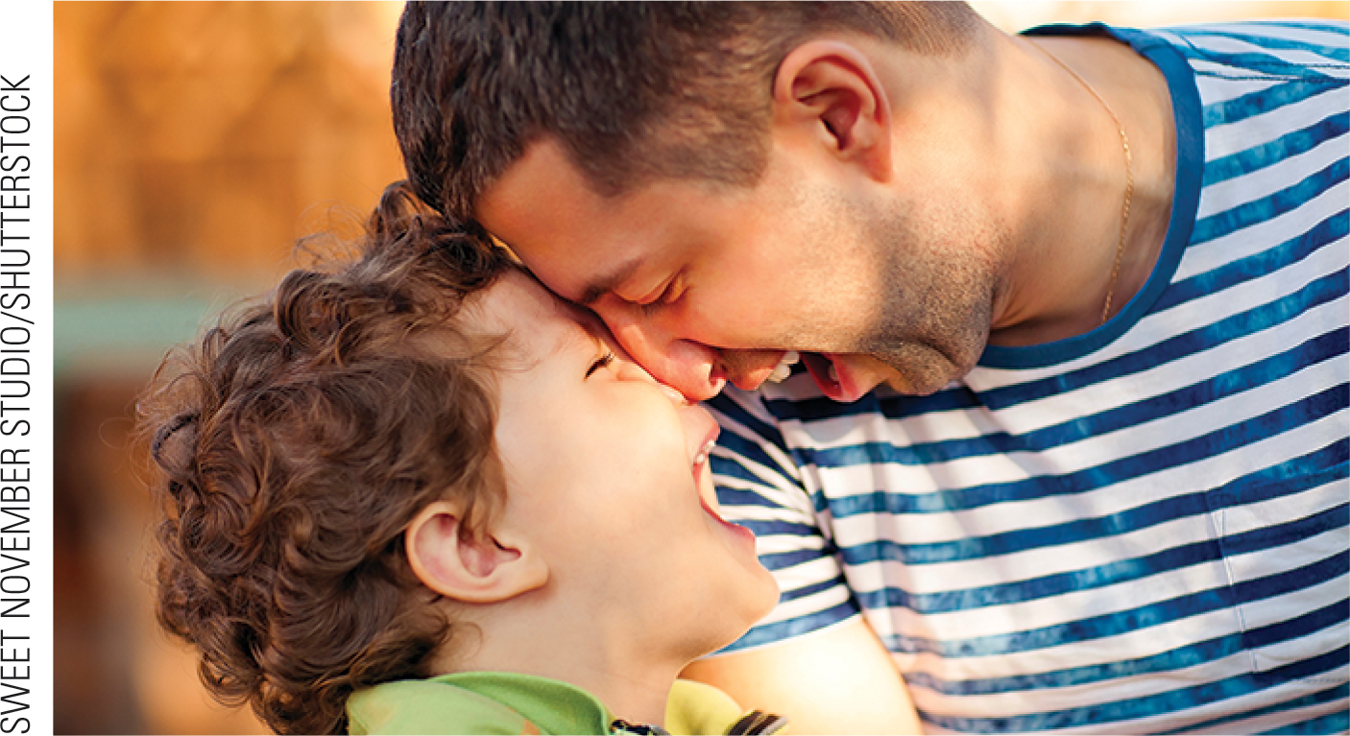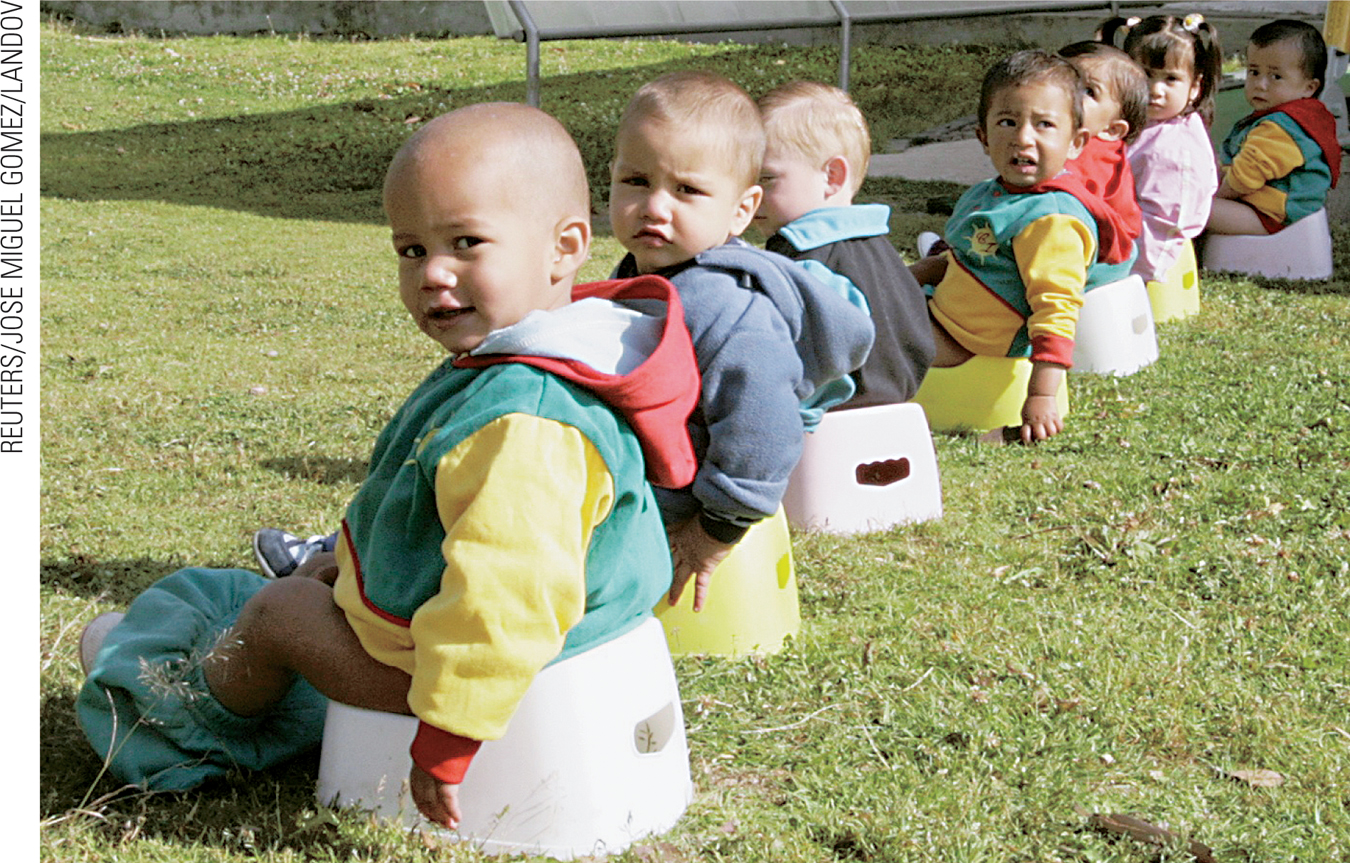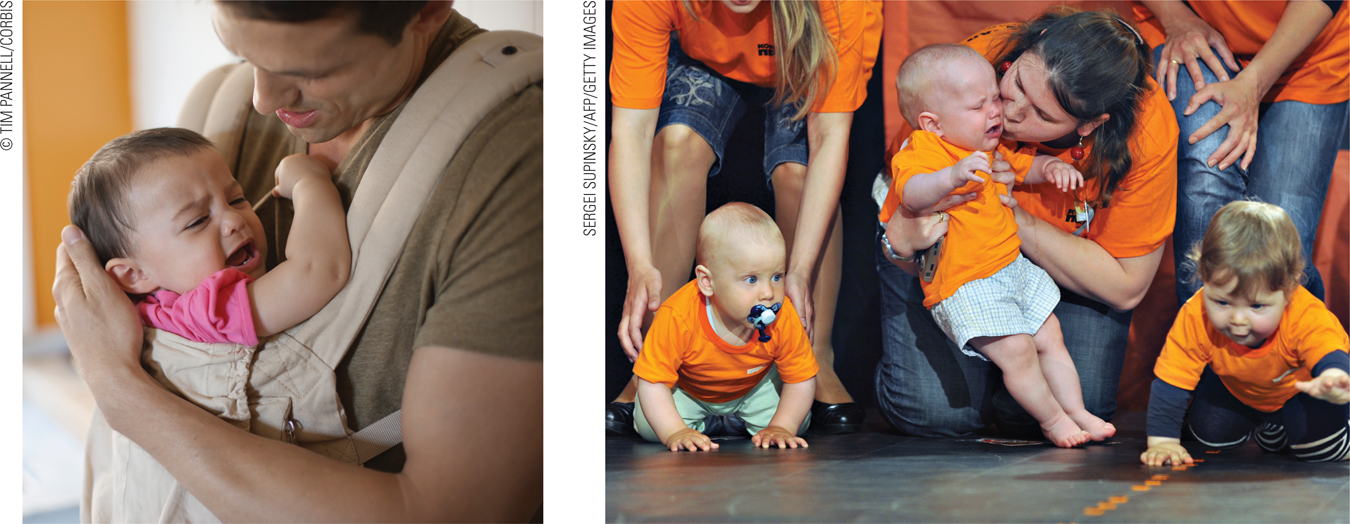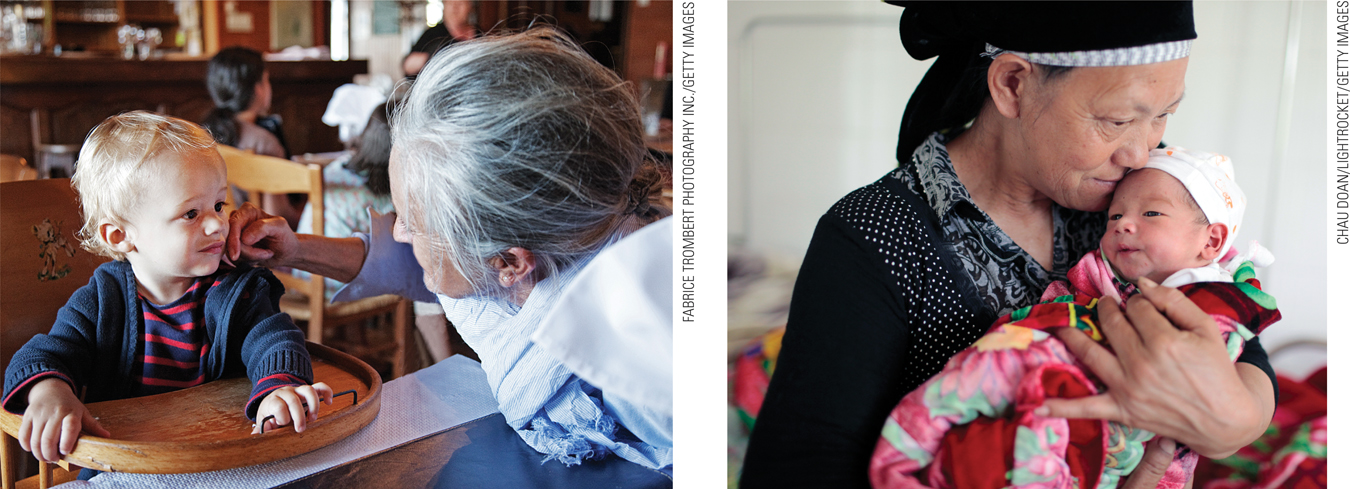Theories of Infant Psychosocial Development

Video: Theories of Emotional Development in Infancy and Toddlerhood summarizes the theories of personality development described in this section.

Consider again the theories discussed in Chapter 2. As you will see, theories lead to insight and applications that are relevant for the final topic of this chapter, infant day care.
You will notice that the two universal theories, humanism and evolution, are discussed separately. That is because the implications of each for infants diverge, and thus they should not be lumped together.
You will also see that sociocultural theory is not described as a separate theory. From that omission do not conclude that it is irrelevant—
Psychoanalytic Theory
Psychoanalytic theory connects biosocial and psychosocial development. Sigmund Freud and Erik Erikson each described two distinct stages of early development, one in the first year and one beginning in the second.
Freud: Oral and Anal Stages
Especially for Nursing Mothers You have heard that if you wean your child too early he or she will overeat or develop alcoholism. Is it true?
Freud thought so, but there is no experimental evidence that weaning, even when ill-
According to Freud (1935/1989, 2001), the first year of life is the oral stage, so named because the mouth is the young infant’s primary source of gratification. In the second year, with the anal stage, pleasure comes from the anus—
Freud believed that the oral and anal stages are fraught with potential conflicts. If a mother frustrates her infant’s urge to suck—
225
Similarly, if toilet training is overly strict or if it begins before the infant is mature enough, then the toddler’s refusal—
Erikson: Trust and Autonomy
According to Erikson, the first crisis of life is trust versus mistrust, when infants learn whether or not the world can be trusted to satisfy basic needs. Babies feel secure when food and comfort are provided with “consistency, continuity, and sameness of experience” (Erikson, 1963, p. 247). If social interaction inspires trust, the child (later the adult) confidently explores the social world.

The second crisis is autonomy versus shame and doubt, beginning at about 18 months, when self-
Erikson was aware of cultural variations. He knew that mistrust and shame could be destructive or not, depending on local norms and expectations. Westerners expect toddlers to go through the stubborn and defiant “terrible twos”; that is a sign of the urge for autonomy. Parents in some other places expect toddlers to be more responsive to parent demands, using shame to control misbehavior.
A study of children in three nations found that the Japanese were highest in shame, the Koreans highest in guilt, and the U.S. children highest in pride (Furukawa et al., 2012). As a result, U.S. children are less fearful and less obedient.
Behaviorism

From the perspective of behaviorism, emotions and personality are molded as parents reinforce or punish a child. Behaviorists believe that parents who respond joyously to every glimmer of a grin will have children with a sunny disposition. The opposite is also true:
Failure to bring up a happy child, a well-
[Watson, 1928, pp. 7, 45]
Later behaviorists recognized that infant behavior also has an element of social learning, as infants learn from other people. You already saw an example, social referencing. Social learning occurs throughout life (Morris et al., 2007; Rendell et al., 2011). Toddlers express emotions in various ways—
For example, a boy might develop a hot temper if his father’s outbursts seem to win his mother’s respect; a girl might be coy, or passive-
226
Parents often unwittingly encourage certain traits in their children. This is evident in the effects of proximal versus distal parenting. Should parents carry infants most of the time, or will that spoil them? Should babies have many toys, or will that make them too materialistic?
Answers to these questions refer to the distinction between proximal parenting (being physically close to a baby, often holding and touching) and distal parenting (keeping some distance—
Variations in proximal and distal parenting lead to variations in toddler behavior. For instance, toddlers who, as infants, were often held, patted, and hushed (proximal) become toddlers who are more obedient to their parents but less likely to recognize themselves in a mirror (Keller et al., 2010; Keller et al., 2004). Cultural differences in personality are apparent when researchers compared the Nso people of Cameroon (very proximal) with the Greeks in Athens (very distal). Further research in other nations confirms that caregiving styles affect later behavior (Borke et al., 2007; Kärtner et al., 2011).
Especially for Pediatricians A mother complains that her toddler refuses to stay in the car seat, spits out disliked foods, and almost never does what she says. How should you respond?
Consider the origins of the misbehavior—
Should you pick up your crying baby (proximal) or give her a pacifier (distal)? Should you breast-
Cognitive Theory
Cognitive theory holds that thoughts determine a person’s perspective. Early experiences are important because beliefs, perceptions, and memories make them so, not because they are buried in the unconscious (psychoanalytic theory) or burned into the brain’s patterns (behaviorism).

According to many cognitive theorists, early experiences help infants develop a working model, which is a set of assumptions that becomes a frame of reference for later life (Johnson et al., 2010). It is a “model” because early relationships form a prototype, or blueprint; it is “working” because it is a work in progress, not fixed or final.
Ideally, infants develop “a working model of the self as lovable, and competent” because the parents are “emotionally available, loving, and supportive of mastery efforts” (Harter and Bukowski, 2012, p. 12). However, reality does not always conform to this ideal. A 1-
The crucial idea, according to cognitive theory, is that an infant’s early experiences themselves are not necessarily pivotal, but the interpretation of those experiences is (Olson & Dweck, 2009). Children may misinterpret their experiences, or parents may offer inaccurate explanations, and these form ideas that affect later thinking and behavior.
In this way, working models formed in childhood echo lifelong. A hopeful message from cognitive theory is that people can rethink and reorganize their thoughts, developing new models. Our mistrustful girl might marry a faithful and loving man and gradually develop a new working model. The form of psychotherapy that seems most successful at the moment is called cognitive-
227

Humanism
Remember from Chapter 2 that Maslow described a hierarchy of needs (physiological, safety/security, love/belonging, success/esteem, and self-
Humanism reminds us that caregivers also have needs and that their needs influence how they respond to infants. Self-
For example, while all experts endorse breast-
For example, one mother of a 1-
My son couldn’t latch so I was pumping and my breasts were massive and I’m a pretty small woman with big breasts and they were enormous during pregnancy. It has always been a sore spot for me and I’ve never loved my breasts. And that has been hard for me in not feeling good about myself. And I stopped pumping in January and slowly they are going back and I’m beginning to feel some confidence again and that definitely helps. Because I felt overweight, your boobs are not your own and you are exhausted and your body is strange it’s just really hard to want to share that with someone. They think you are beautiful, they love it and love you the way you are but it is not necessarily what you feel.
[quoted in Shapiro, 2011, p. 18]
228
This woman’s need for self-
Her personal needs may have been unmet since puberty (she says, “I’ve never loved my breasts”). She blames her husband for not understanding her feelings and her son who “couldn’t latch.” Since all babies learn to latch with time and help, this woman’s saying that her son couldn’t latch suggests something amiss in synchrony and attachment—
By contrast, some parents understand their baby’s need for safety and security (level 2) even if they themselves are far beyond that stage. Kevin is an example.
Kevin is a very active, outgoing person who loves to try new things. Today he takes his 11-
[Lerner & Dombro, 2004, p. 42]
Evolutionary Theory
Remember that evolutionary theory stresses two needs: survival and reproduction. Human brains are extraordinarily adept at those tasks. However, not until about two decades of maturation is the human brain fully functioning. A child must be nourished, protected, and taught much longer than offspring of any other species. Infant and parent emotions ensure this lengthy protection (Hrdy, 2009).
Emotions for Survival
Infant emotions are part of this evolutionary mandate. All the reactions described in the first part of this chapter—
For example, newborns are extraordinarily dependent, unable to walk or talk or even sit up and feed themselves for months after birth. They must attract adult devotion—
Adults call their hairless, chinless, round-
If humans were motivated merely by financial reward, no one would have children. Yet evolution has created adults who find parenting worth every sacrifice. The costs are substantial: Food (even breast milk requires the mother to eat more), diapers, clothes, furniture, medical bills, toys, and child care (whether paid or unpaid) are just a start.
Before a child becomes independent, many parents have bought a bigger residence, and spent thousands on education, vacations, and much more. These are only the financial costs; the emotional costs are greater. A recent book about parenting titled “All Joy and No Fun” highlights the paradox: People choose to sacrifice time, money, and fun because they find parenting deeply satisfying (Senior, 2014).
229

Indeed, successful reproduction depends on years of self-
Evolutionary theory holds that over human history, attachment, with proximity-
As explained in Chapter 4, human bonding is unlike that of goats and sheep—
Allocare
Evolutionary social scientists note that if mothers were exclusive caregivers of each child until adulthood, a given woman could rear only one or two offspring—
Humans birth children at relatively short intervals and raise them successfully because of allocare—the care of children by people other than the biological parents (Hrdy, 2009). Allocare is essential for Homo sapiens’ survival.
Compared with many other species (for instance, mother chimpanzees never let another chimp hold their babies), human mothers have evolved to let other people help with child care, and other people are usually eager to do so (Kachel et al., 2011). Throughout the centuries, the particular person to provide allocare has varied by culture and ecological conditions.
230
Often fathers helped but not always: Some men were far away, fighting, hunting, or seeking work, while some had several wives and a dozen or more children. In those situations, other women (daughters, grandmothers, sisters, friends) and sometimes other men provided allocare (Hrdy, 2009).
SUMMING UP All theories recognize that infant care is crucial: Psychosocial development depends on it. Psychoanalytic theory stresses the effects of early caregiving routines—
Humanists consider the basic needs of adults as well as infants. Consequently, they acknowledge the parental side of the parent–
WHAT HAVE YOU LEARNED?
Question 7.17
bHR7linBRYbwSGriBKOIfgEvT1QGIT+O71K/jZz2gmwzcIsj7GsbMgZ3LxEp60OrMf2spNuHdv4iAnOkUKo6QjvSU2N79KrE35L5KJkd1fM=According to Freud, a person who is stuck in the oral stage may eat or drink to excess, chew tobacco, bite their nails, or talk excessively.Question 7.18
usWo2ldP37K5M+cAPXyVDlBHKGigYggcry7kfq0f6VfaZkmnIO9mXLxEkhhkoRwRHTIjZWLssLeK66ZuIrZX7u274q/5RuwJnroxIDm2KmawmddKIf positive social interactions in infancy inspire trust, later in life the child or adult confidently explores the social world. The inverse would be true for infants who develop mistrust at this stage; they would lack confidence in their engagement with the world and assume that their basic needs cannot be met.Question 7.19
yY0EScGO+MADx2QKpmf/PzcrKJa5iKEpTL9A+S0rlXn26sP3c3VtrMmPEZQTrPNew9vrypJDesdQOj0yjS8d9tfkvPZdB36C/QpmApRu7ghhoHgtgxdQIn6p5/TpIqvuZK8Lv0vB7wdj8dWRErikson was aware of cultural variations. He knew that mistrust and shame could be destructive or not depending on local norms and expectations. Westerners expect toddlers to go through the stubborn and defiant “terrible twos;” that is a sign of the urge for autonomy. Parents in some other places expect toddlers to be more responsive to parent demands, using shame to control misbehavior. A study of children in three nations found that the Japanese were highest in shame, the Koreans highest in guilt, and the U.S. children highest in pride. As a result, U.S. children are less fearful and less obedient.Question 7.20
cUCQhlJIgzX1chIitOIkRUVurofmebpfCOGWX+ZWr/IbGaL40ran8/+6zNuWn/Xr70s/LgCFJzIVfjFTIe+IE5rkF8DQTCSucFvcvg==Behaviorists believe a child's emotions and personality are molded as parents reinforce or punish a child. In addition, behaviorists believe that infants absorb information from the people around them through social learning.Question 7.21
yEXp6rTuM3PFWDMyt6UXQZFrWylP7jWhuFLB2XR8PFfGLwoqZE9A9U/T4eygLCaDofPMX0Zr79JARBQIVGV5p8hHDyI=A working model is formed from early experiences. It is a set of assumptions that becomes a frame of reference for later life based on beliefs, perceptions, and memories; cognitive theorists believe that these very things—beliefs, perceptions, memories— determine a person's perspective in life. In contrast, psychoanalytic theory suggests that early events are buried in the unconscious, and behaviorists propose that they simply provide reinforcements or models for behavior. Question 7.22
9qHsz6bslOIIRZHlZ2I03esA29Xjn//ZVRd+JGQTsnj9AuhGUNhWnu+6DiGlo7/3s4J19eCWlh1AfVhtX+/7Fvfz5hqig1DE9FXvOyrggO9arYZImOOjTOaJrgREkPU/Caregivers clearly have their own needs, and those needs influence how they respond to infants. Self–actualized people no longer have their own unmet needs, so they can nurture an infant well. But most parents are not at the highest level on Maslow's hierarchy and still seek love or respect. In addition, the early experiences of caregivers often include unmet needs, and these can interfere with their ability to nurture. Question 7.23
Kz8n3s04lR5x8VGYzA0DfLYXQBklg3EG8Rr1ThOag+iXARDsBugtb2fQMQ2XfyNVQe2BJOeUnVWlhpuCYCcmYnwKytWarWerSmgSOi13YXZL5w2ipZryrnSD/Dn3T7awYna6fDw070g=Evolutionary theory stresses two needs: survival and reproduction. Newborns are extraordinarily dependent, unable to walk or talk or even sit up and feed themselves for months after birth. Thus, they must attract adult devotion—and they do. The parent– child bond ensures the survival of infants. Question 7.24
kMYSgr9P9MuSbobqJ06ZENvKNRmweNRs4kRT8MdZt2/Qb/2oJO7j1mwKVq32XFTGw6/tWHYEc7+p1yZUJz8hlg==Evolutionary social scientists note that if mothers were the exclusive caregivers of each child until children were adults, a given woman could rear only one or two offspring—not enough for the species to survive. Allocare, the care of children by people other than the biological mother, is necessary so that mothers can have more children than they can care for on their own.